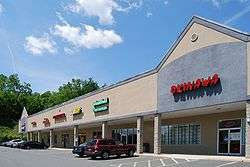Strip mall
A strip mall is a type of open-air shopping center common in North America where the stores are arranged in a row, with a sidewalk in front. Strip malls are typically developed as a unit and have large parking lots in front. Many of them face major traffic arterials and tend to be self-contained with few pedestrian connections to surrounding neighborhoods. Smaller strip malls may be called mini-malls, while larger ones may be called power centers or big box centers.

In 2013, the New York Times reported that the United States had 65,840 strip malls.[1]
In Australia, however, "strip shops", "shopping strip" or "shopping parade" describes a strip of independent shops and buildings along a main shopping street of a "suburb", meaning neighborhood, and thus not set back from the sidewalk (pavement) by a parking lot[2] — in the U.K. known as a "high street" and in the U.S. a "shopping street".
Current status
In 2020 the Wall Street Journal wrote that in the U.S., despite the continuing demise of the shopping mall and the retail apocalypse starting around 2010, investments and visitor numbers were increasing to strip malls.[3]
Characteristics
In the United States and Canada, strip malls usually range in size from 5,000 square feet (460 m2) to over 100,000 square feet (9,300 m2). Power centers, described below, may also be considered strip malls, and may reach 2.3 million square feet (210,000 m2).[4]
Types
Mini-mall
The smaller variety is more common and often located at the intersection of major streets in residential areas; it caters to a small residential area.[1] This type of strip mall is found in nearly every city or town in the United States and Canada; it is service-oriented and may contain a grocery store, hair salon, dry cleaner, laundromat, small restaurant, discount stores, variety stores, and similar stores such as a general store, toy store, pet store, jewelry store, mattress store, Convenience store, thrift shop, or pawn shop. In the past, pharmacies were often located next to the grocery stores, but are now often free-standing or contained within the anchor tenant (e.g. Walmart, Target) or grocery store. Gas stations, banks, and other businesses also may have their own free-standing buildings in the parking lot of the strip center.
Mini-malls in Los Angeles
The mini-mall in Los Angeles is seen as the descendant of the drive-in markets with multiple independent vendors that appeared in the area in the 1920s. The 1973 oil crisis bankrupted many gas stations, freeing up their corner lots for redevelopment. La Mancha developers built the first modern-style mini-mall – a few stores with parking in front – in Panorama City, Los Angeles in 1973, with more than 600 to follow in the metropolitan area. The proliferation of mini-malls from that time into the 1980s led to a 1988 anti-mini-mall ordinance in the City of Los Angeles.[5][6][7]
Big box center / power center
The other variety of strip mall in the United States is usually anchored on one end by a big box retailer, such as Walmart, Kohl's or Target, and/or by a large supermarket like Kroger, Publix or Winn-Dixie on the other. They are usually referred to as power centers in the real estate development industry because they attract and cater to residents of an expanded population area. The categories of retailers may vary widely, from electronics stores to bookstores to home improvement stores, dollar stores, and boutiques. There are typically only a few of this type of strip malls in a city, compared to the smaller types. Retailers vary from center to center, ranging from three or four large retailers to a dozen or more.
Some strip malls are hybrids of these types.
See also
- Retail park, a UK term for a grouping of retail stores, usually the equivalent of a power center
- Types of retail outlets
References
- Kramer, Andrew E. (January 1, 2013). "With a Mall Boom in Russia, Investors Go Shopping". New York Times. Retrieved September 11, 2013.
- Featherstone, Tony (August 30, 2017). "Local shopping precincts suffer as giant malls become the de-facto town centre". The Sydney Morning Herald. Retrieved March 29, 2020.
- Fung, Esther (January 14, 2020). "Strip Centers Shine as Some Shoppers Sour on Malls". The Wall Street Journal. Retrieved January 15, 2020 – via Apple News.
- "About Us". South Edmonton Common. Retrieved March 17, 2019.
- https://www.latimes.com/archives/la-xpm-1997-nov-16-tm-54209-story.html
- https://la.curbed.com/2019/10/2/20882316/strip-malls-los-angeles
- https://latimesblogs.latimes.com/lanow/2008/03/your-neighborho.html
External links
| Wikimedia Commons has media related to Strip malls. |
- Localcenters – Commercial Strip Mall Reference Site